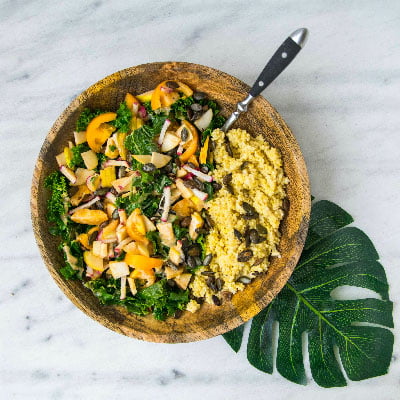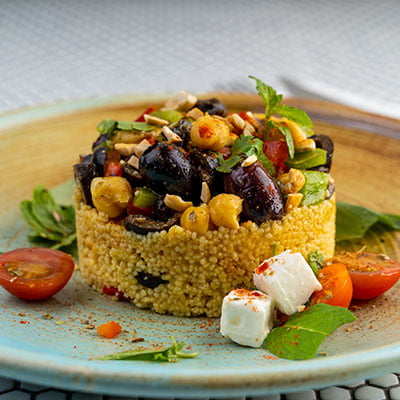Couscous is a Berber transitional North African dish of semolina. With its neutral taste and quick cooking time, couscous has gained global popularity, and it works well in a flavorful main dish or as a protein-rich side. However, with its unique appearance and small size, many people have to ask - what is couscous?
What Is Couscous?
Popular belief is that couscous is a type of whole grain, and it appears to be something like a seed or rice, but it's pasta made from semolina flour and water. Traditionally, a bowl of semolina would be mixed by hand with small amounts of water, rolling into very tiny, irregular pieces.
Semolina flour is made from durum wheat, which is very hard and has a higher protein content than all-purpose wheat flour. Semolina flour is golden yellow rather than white or brown, which lends a nutty taste to the couscous. Remember that couscous is made from wheat, and it is not a gluten-free option.
Different cultures had different starches to use as a dietary base. Couscous is this staple starch in North African cultures, where meat can be scarce. It is the blank canvas, the carrier of any combination of flavors you wish to add to it.
What Does Couscous Taste Like?
Couscous, crafted from semolina wheat or durum wheat, is a petite and granular pasta. It boasts a gentle, nutty taste with a hint of chewiness. While reminiscent of rice or pasta, couscous sets itself apart with its delicate and airy texture, offering a uniquely fluffy experience. Couscous doesn't have a strong taste on its own, so it easily absorbs the flavors of other ingredients and seasonings used in a dish. It is commonly used as a base for stews, salads, and side dishes in the Mediterranean and North African cuisines.
Is couscous gluten-free?
Unfortunately, traditional couscous is not suitable for a gluten-free diet. Couscous is made from semolina wheat or durum wheat, both of which contain gluten.
Types Of Couscous
In grocery stores, you can find the following types of couscous:
Moroccan Couscous
Moroccan couscous is the smallest of the various couscous sizes. It looks exactly what most people think of when it comes to couscous, and each piece is only slightly larger than a grain of semolina flour. While Moroccan couscous is still handmade in many counties, it is not in the United States. Here, you will often find it machine-made, pre-steamed, dried, and then packaged in portion-sized boxes in any grocery store. Traditional couscous is triple-steamed in a special pot called a couscoussier.
Israeli Couscous
Israeli couscous is larger and rounder. While couscous isn't a traditional Israeli food, grains became scarce in Israel in the 1950s. Israeli couscous was then invented so that the large amounts of immigrants arriving daily could be fed. Its larger size lends it a chewier texture.
Pearl Couscous
Pearl couscous is simply another name for Israeli couscous. The little balls of dough do look similar to small pearls.
Lebanese Couscous
Lebanese couscous, also called moghrabieh couscous, is even larger than Israeli couscous. This couscous is found in feast dishes alongside beef or lamb rather than being a starch staple in meat-scarce regions.
Whole Wheat Couscous
Whole wheat couscous is considered slightly more nutritious than all the other types. Unlike other couscous, whole-wheat couscous is made from whole-wheat durum flour, and it has a mild flavor and contains more fiber and more nutrition.
Maftoul
Maftoul, also known as Palestinian couscous, is a larger-grained couscous made from bulgur wheat, and it has a more substantial texture and a slightly nutty taste. Maftoul is often used in traditional Middle Eastern and Palestinian dishes.
Sorghum Couscous
Sorghum couscous is made from sorghum grains, which are gluten-free and suitable for those with wheat allergies or gluten sensitivities. It offers a distinctive texture and flavor that sets it apart from traditional wheat-based couscous.

How Do You Cook Couscous?
Cooking couscous is a straightforward process. Here's a basic method for cooking regular couscous:
Pre-Toast (Optional)
Before cooking couscous to boiling liquid, you can give it a quick toast in a skillet. Toss the tiny granules in a skillet with extra virgin olive oil and cook until golden brown. Then cook it in liquid.
Step 1 Measure the couscous
Accurately measure the desired quantity of couscous using a measuring cup. As a general rule, use a 1:1.5 ratio of couscous to liquid. For instance, when preparing 1 cup of couscous, you'll require 1.5 cups of liquid. Add some extra virgin olive oil and toss it evenly with couscous to prevent clumping while it steams.
Step 2 Heat the liquid
In a saucepan or kettle, bring the liquid (water or broth) to a boil. Take your couscous recipe to the next level by adding a pinch of salt and a small amount of lemon juice or lemon zest. You can also consider using chicken broth as your cooking liquid instead of water for extra flavor.
Step 3 Add couscous to the liquid
Once the liquid is boiling, remove it from the heat and immediately add the couscous to the pot of boiling water. Stir the couscous to ensure it's evenly distributed.
Step 4 Let it steam
Place a lid on the pot, allowing the couscous to steam undisturbed for approximately 5 minutes. This allows the couscous to absorb the liquid and become tender.
Step 5 Fluff with a fork
Once the steaming is complete, remove the lid and delicately fluff the couscous using a fork. This gentle action separates the grains, preventing them from clumping together.
Step 6 Serve and enjoy
The couscous is now ready to be served as a side dish, in salads, or as a base for various recipes. Season it with herbs, spices, or dressings according to your taste preferences.

How Do You Eat Couscous?
Wondering how to eat couscous? Well, the possibilities are as endless as your imagination! Once you have cooked couscous, there are tons of couscous recipes to try! From simple salads to hearty main courses, couscous is a culinary chameleon that can adapt to any flavor profile you desire.
Couscous Salad
Indulge in a revitalizing couscous salad that bursts with vibrant hues and zesty Mediterranean tastes. This salad combines juicy tomatoes, crisp cucumbers, tangy feta cheese, pine nuts, fresh herbs, lemon zest, lemon juice, and a drizzle of olive oil. With every bite, you'll be transported to the sun-kissed shores of the Mediterranean, immersing yourself in the delightful sensations of a perfect summer dish.
How To Store Uncooked Couscous
Store the uncooked couscous in an airtight container or resealable bag. Store it in a cool and dry area, such as a pantry or cupboard, away from direct sunlight, heat sources, and moisture. This helps maintain its quality and prevents moisture from being absorbed.
Ensure that the container or bag is securely sealed to prevent any air from entering. Oxygen exposure can lead to spoilage or loss of quality over time.
FAQs
Can couscous be eaten cold, or is it typically served hot?
Couscous can be savored, either hot or cold, depending on individual preferences and the intended culinary creation.
Traditional couscous is typically cooked and served hot, and it is commonly used as a base for stews, tagines, or saucy dishes. Once cooked, hot couscous has a fluffy and tender texture, making it a comforting and satisfying option.
Couscous can also be served cold, making it a refreshing choice for salads, cold sides, or chilled grain bowls. After cooking and cooling the couscous, it can be mixed with various ingredients like vegetables, herbs, dressings, or vinaigrettes to create a vibrant and flavorful cold dish. Cold couscous can be a great option for picnics, potlucks, or as a make-ahead meal.
Can couscous be used in salads?
Yes, couscous is commonly used in salads and is a popular ingredient for adding texture and substance to various salad recipes. An example of a Mediterranean couscous salad combines cooked and cooled couscous with cherry tomatoes, cucumbers, red onions, olives, feta cheese, fresh herbs (such as parsley and mint), lemon juice, and olive oil.
How long does cooked couscous last in the refrigerator?
When stored appropriately in the refrigerator, cooked couscous can generally remain fresh for about 3 to 5 days. Let the cooked couscous cool down to room temperature before refrigerating. To prevent condensation and excess moisture buildup, it's important to allow the cooked couscous to cool before storage. Once cooled, transfer the couscous to an airtight container or resealable bag, ensuring a tight seal to prevent air and moisture from entering. Promptly place the container of cooked couscous in the refrigerator as soon as possible after cooking. The cooler temperature of the refrigerator slows down bacterial growth and helps maintain the quality and freshness of the couscous.
How do you season or flavor couscous?
Couscous, being a versatile grain, readily lends itself to a variety of seasonings and flavors that can elevate its taste to new heights. You can flavor it with cooking water, and using chicken broth or vegetable stock can infuse the couscous with flavor.
Elevate the flavor of couscous by incorporating a range of dried or fresh herbs and spices. Common options include parsley, cilantro, basil, thyme, cumin, paprika, turmeric, or garlic powder.
Sauté or mix in aromatics like minced garlic, shallots, or onions to infuse the couscous with aromatic flavors.
